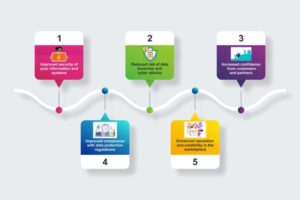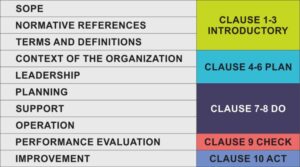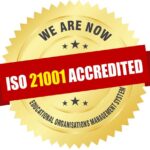Learn More about ISMS ISO 27001 Certification
Have you ever wondered what goes into ISO 27001 certification? It’s a topic that’s likely to come up more and more in the business world, as more and more companies strive to improve their cyber security posture. In this blog post, we will explore what ISO 27001 certification is and what it entails. We will also debunk some common myths about the certification process. By the end of this post, you should have a better understanding of what ISO 27001 certification is and how it can benefit your business.
What is ISMS ISO 27001 Certification ?
ISO 27001 certification is an international standard that provides requirements for an information security management system (ISMS). Organizations that implement an ISMS can be certified by an accredited certification body.
An ISMS is a framework of policies and procedures that includes all legal, physical and technical controls involved in an organization’s information risk management processes. ISO 27001 certification demonstrates that an organization has implemented an ISMS in line with international best practices.
Organizations certified to ISO 27001 must undergo regular audits to ensure that their ISMS continues to meet the requirements of the standard. Certification is valid for three years and can be renewed indefinitely.
How to get ISO 27001 Certified
There are a few steps you need to take in order to get your organization ISO 27001 certified.
1. The first step is to develop your organization’s information security management system (ISMS). This system should be tailored to the specific needs of your organization and include all aspects of information security, from Policies and Procedures to Risk Management.
2. Once your ISMS is developed, you will need to have it audited by an accredited certification body. This audit will ensure that your ISMS meets all the requirements of the ISO 27001 standard.
3. Once you have passed the certification audit, you will be issued an ISO 27001 certificate, which is valid for three years. In order to maintain your certification, you will need to undergo annual surveillance audits and recertification audits every three years.
The Benefits of ISO 27001 Certification
There are many benefits to achieving ISO 27001 certification, including :-

As the world becomes increasingly digital, the need for robust information security grows. ISO 27001 is the international standard that provides a framework for an effective Information Security Management System (ISMS). ISO 27001 demonstrates that your organization takes information security seriously and is committed to protecting your data.
Achieving certification requires a comprehensive approach to information security, covering people, processes and technology. The ISO 27001 benefits of certification will be felt across your entire organization, from the boardroom to the frontline. Your customers and partners will have increased confidence in your ability to keep their data safe, while you reap the rewards of reduced risk and improved compliance.
What’s required for ISO 27001 Information Security Management System Certification (ISMS) ?
In order to be certified to ISO 27001, organizations must meet the requirements outlined in the standard. This includes having a documented Information Security Management System (ISMS) in place that covers all aspects of security, from risk assessment and treatment to incident management. The ISMS must be implemented and maintained according to the ISO 27001 standard, and the organization must be able to demonstrate its compliance through an external audit.
Tips for maintaining ISMS ISO 27001 Certification
There are a few key things to keep in mind when working towards and maintaining ISO 27001 certification :-
- Keep your documentation up to date and accurate. This includes your security policy, risk assessment, and any procedures or controls you have in place.
- Make sure all employees are aware of the importance of compliance and security, and that they understand their roles and responsibilities in relation to ISO 27001.
- Regularly review your security posture and make sure you are taking steps to address any identified risks.
- Maintain an incident response plan so you know how to deal with any potential security breaches.
By following these tips, you can help ensure that your organization remains compliant with ISO 27001 and keeps its certification status.
What are the major changes in ISO/IEC 27001:2022 in 2022
Some of the main new updates of ISO/IEC 27001:2022 include a major change of Annex A, minor updates of the clauses, and a change in the title of the standard. The latest version of ISO/IEC 27002 has been published at the beginning of 2022, and its latest changes have also impacted ISO/IEC 27001.
Requirements of ISO 27001 Certifications
Context to the Organization
Existing – Context to the Organization – It requires an organization to define the scope of ISMS and identify all the internal and external issues related to its information security and the expectations of the interested parties.
New – Context to the Organization – An organization must understand the context of the organization and define its scope to establish an effective Information Security Management System. The latest update requires an organization to identify only the relevant requirements, which will be addressed through the Information Security Management System (ISMS).
Planning
Existing – It requires an organization to define its information security objectives based on the risk assessment and implement appropriate controls listed in Annex A. It determines plans and actions to address risks and opportunities and prepares a Statement of Applicability (SoA).
New – An organization requires defining its information security objectives based on the risk assessment and implementing appropriate controls listed in Annex A. It also requires documenting the available information and determining plans and actions to address risks and opportunities and preparing a Statement of Applicability (SoA).
Support
Existing – It focuses on the competence of personnel, resources, people and infrastructure and establishes sound communication, including external and internal, to establish a sound ISMS. It provides necessary training to the employees and requires documenting information related to information security.
New – It aims to enhance the competence of personnel, resources, people and infrastructure and establishes sound communication, including external and internal, to establish a sound ISMS. An organization shall focus on “how to communicate” rather than “who will communicate.”
Operation
Existing – This clause works in line with Clause 6 and focuses on the execution of all the plans and processes. It outlines the outcomes of the risk assessment and requires maintaining all the related documents. It focuses on implementing risk assessment and treatment plans to establish an efficient Information Security Management System.
New – This clause works in line with Clause 6. The latest update replaces the requirements to plan how to achieve the information security objectives with establishing criteria for processes to implement the actions identified in the planning clause. An organization must control its external processes, products, and services related to ISMS.
Performance Evaluation
Existing – It requires an organization to monitor, measure, analyze and evaluate the ISMS to ensure its effectiveness and efficiency. It evaluates the organization’s performance to the defined objectives. This clause also requires an organization to conduct internal audits to review its Information Security Management System (ISMS).
New – An organization shall adopt comparable and reproducible methods to monitor, measure, analyze and evaluate the ISMS to ensure its effectiveness and efficiency. It evaluates the organization’s performance to the defined objectives. This clause also requires an organization to conduct internal audits to management review to measure its Information Security Management System (ISMS) and make necessary changes to meet the needs and requirements of interested parties.
Annex A Security Control
New – The number of Annex A Security Controls is reduced from 114 to 93 controls. These controls are further divided into 4 themes rather than 14 domains.
- People (8 controls)
- Organizational (37 controls)
- Technological (34 controls)
- Physical (14 controls)
The new ISO 27001:2022 version introduces 11 new controls to the Annex A Security Control list. These new controls are:-
- Threat Intelligence
- Information Security for the Use of Cloud Services
- ICT Readiness for Business Continuity
- Physical Security Monitoring
- Configuration Management
- Information Deletion
- Data Masking
- Data Leakage Prevention
- Monitoring Activities
- Web Filtering
- Secure Coding
Existing –
ISO 27001 Annex A Controls or ISO 27001 controls . They are grouped into 14 domains. These are:-
- Information Security Policies
- Organization of Information Security
- Human Resources Security
- Asset Management
- Access Control
- Cryptography
- Physical and Environmental Security
- Operational Security
- Communications Security
- System Acquisitions, Development and Maintenance
- Supplier Relationships
- Information Security Incident Management
- Information Security Aspects of Business Continuity Management
- Compliance
PDCA Cycle
- Do – to execute a planned action which will help us achieve the required objective
- Plan – to think that what do we need to achieve in our organization
- Check – monitor against the standards) (policies, objectives, requirements)
- Action – finally implementing what has been rechecked.
How SIS Certifications can help you
ISO 27001 certification is a great way to show your commitment to security and demonstrate that you have implemented best practices. Getting certified can be a complex process, but it is well worth the effort to ensure that your organization is protected against potential threats. Our team of experts can help you navigate the certification process and ensure that you are prepared for success. Contact us today to learn more about how we can help you get ISO 27001 certified.
Frequently Asked Questions (FAQs) about ISO 27001
Question: What is the purpose of getting ISO 27001 Certification for Companies?
Answer: In the year 2022 the average global data breach cost was around $4.35 million which meant companies lack the necessary strategy to prevent their data from possible threats. ISO 27001 being a single part of the ISO 27000 family of security standards enables the integration of full-fledged ISMS within an organization. It addresses how organizations establish, maintain, monitor, and improve their ISMS to secure their data, documents, and other information assets.
Question: What is ISO 27001 Certification?
Answer: ISO/IEC 27001 is an international standard that helps in the effective implementation of enterprise-wide Information Security Management System (ISMS) which is an organized way to maintain confidentiality and integrity within an organization. Along the same lines, ISO 27000 is a series of best practices to help organizations improve their information security management systems.
Stage One (documentation review) – At this stage, the auditors from the certification body verify that your documentation meets the requirements of ISO 27001 certification.
Stage Two (main audit) – In this stage, the realities of your processes are matched with your statements in the documentation for their compliance to the requirements of ISO 27001 standard.
The certification process goes further. Click here to view the next steps to the ISO certification process
Once you have implemented the ISMS in your organization, it becomes necessary for you to get yourself audited in order to achieve the ISO 27001 certification. When you choose an external certification body to perform the audits, you need to first fill up the application form. Once you have reviewed all the requirements of the certification, you may plan your audits accordingly.


